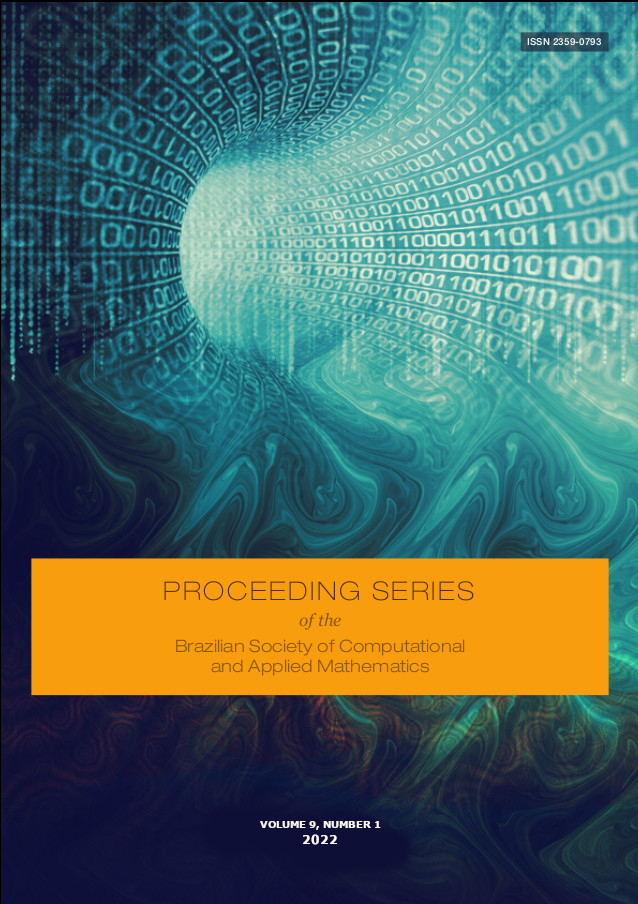Escoamentos de fluidos magnéticos em uma cavidade
DOI:
https://doi.org/10.5540/03.2022.009.01.0254Palavras-chave:
cavidade com parede móvel, fluido magnético, magnetização, diferenças finitas, formulação vorticidade-função de corrente, equações de Shliomis.Resumo
Neste trabalho, estudamos escoamentos de fluidos magnéticos em uma cavidade com parede superior móvel. Propomos uma formulação vorticidade-função de corrente para resolver o escoamento e a equação de evolução da magnetização. As equações que regem o escoamento foram discretizadas utilizando o método de diferenças finitas. Identificamos os principais parâmetros físicos na dimensionais do problema como o número de Reynolds, coeficiente de pressão magnética, tempo de relaxação magnética, magnetização de saturação e a intensidade adimensional do campo aplicado. O campo magnético é gerado por um fio condutor pelo qual passa uma corrente elétrica permanente. Nesta geometria bem conhecida, estudamos os efeitos do campo magnético no escoamento.
Downloads
Referências
F. R. Cunha, A. P. Rosa e N. J. Dias. “Rheology of a very dilute magnetic suspension with micro-structures of nanoparticles”. Em: Journal of Magnetism and Magnetic Materials 397 (2016), pp. 266–274.
F. R. Cunha e Y. D. Sobral. “Characterization of the physical parameters in a process of magnetic separation and pressure-driven flow of a magnetic fluid”. Em: Physica A: Statistical Mechanics and its Applications 343 (2004), pp. 36–64.
E. J. Hinch. Think Before You Compute: A Prelude to Computational Fluid Dynamics. Cambridge Texts in Applied Mathematics, 2020.
S.S. Papell. “Low viscosity magnetic fluid obtained by the colloidal suspension of magnetic particles”. Em: U.S. Patent (1965), pp. 215–572.
A. P. Rosa e F. R. Cunha. “Calculation of the Flow of a Magnetic Fluid in Capillaries Tubes with varying Magnetization by Vorticity”. Em: Proceedings of International Congress of Mechanical Engineering 1 (2013), pp. 1–11.
A. P. Rosa, R. G. Gontijo e F. R. Cunha. “Laminar pipe flow with drag reduction induced by a magnetic field gradient”. Em: Applied Mathematical Modelling 40 (2016), pp. 3907– 3918.
R. E. Rosensweig. Ferrohydrodynamics. Courier Corporation. 2013.
P.N. Shankar e M.D. Deshpande. “Fluid mechanics in the driven cavity”. Em: Annual Review of Fluid Mechanics 32 (2000), pp. 93–136.
M. I. Shliomis. “Effective viscosity of magnetic suspensions”. Em: Zh. Eksp. Teor. Fiz 61 (1971), s1971d.
C. Singh, A. K. Das e P. K. Das. “Flow restrictive and shear reducing effect of magnetization relaxation in ferrofluid cavity flow”. Em: Physics of Fluids 28 (2016), p. 087103.
E. E. Tzirtzilakis. “A simple numerical methodology for BFD problems using stream function vorticity formulation”. Em: Communications in Numerical Methods in Engineering 24 (2008), pp. 683–700.
E. E. Tzirtzilakis e M. A. Xenos. “Biomagnetic fluid flow in a driven cavity”. Em: Meccanica 48 (2013), pp. 187–200.
C. O. Vieira. “Simulação Computacional de E

